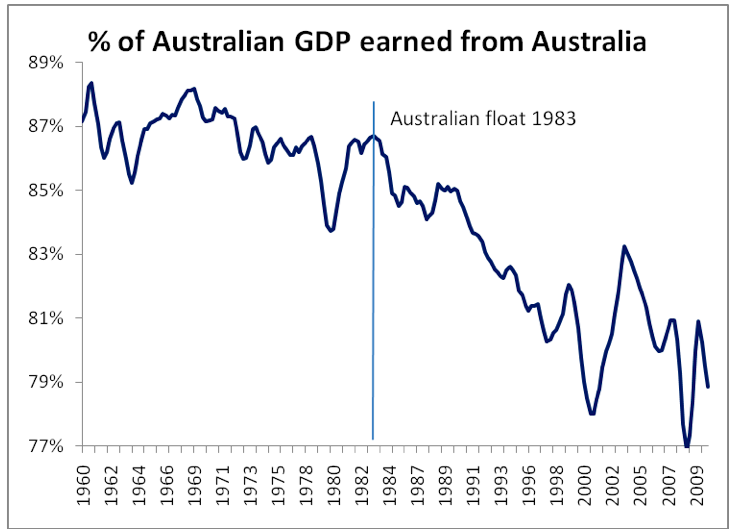Leigh Harkness is back with his unique perspective on the Australian macro-economy for another guest post, this time on “Bank Welfare”.
Banks have prospered under the floating exchange rate system. They have been able to lend as much as they like without any concern about affecting the balance of payments. The exchange rate adjusts to ensure that their lending activities do not affect foreign reserves.
Life for the Reserve Bank has been easier, also. Speculators no longer threaten the currency, nor the level of foreign reserves. The Reserve Bank only has to concern itself about excessive credit growth that may cause inflation.
To control inflation, the Reserve Bank has been using interest rates. This suits the banks because when monetary policy is eased, they can profit from credit growth; when monetary policy is tight, they can profit from the higher interest rates.
The floating exchange system has allowed bank credit to grow at an average rate of 11% per annum since it was introduced. However, real growth in the remainder of the economy has been much slower at only 3.7% per annum. Even including inflation, GDP has been growing at less than 7%. That means that the ratio of bank credit to GDP has been rising at around 4% per annum.
That difference is going to mean that one day the economy will not be able to sustain the growing level of debt. At that point, banks may not be so impressed by the floating exchange rate system. But when that happens, the rest of the country is likely to support the banks with new measures. Our monetary system cannot be allowed to fail.
For industry, the floating exchange rate system has produced a volatile exchange rate that is not conducive to long-term investment. It cannot rely on the price of imported substitutes remaining as they are in the medium term. Also, it has resulted in slower economic growth. Before the US floated its exchange rate, the real rate of economic growth in Australia was 4.8%. (The Australian dollar was tied to the US dollar when it floated.) Since the US float, the rate of economic growth in Australia has fallen to 3.2% per annum.
One of the main reasons for the slower rate of economic growth has been the elimination of the export multiplier. Under fixed exchange rates, if exports increased, additional money would flow into the country and stimulate the economy. That stimulus would continue while export income was greater than spending on imports. For example, if a country spent one eighth of its income on exports, if exports increased by $1 billion, income in the economy would have to grow by $8 billion before it returned to equilibrium. It was the disequilibrium that generated economic growth.
Under the floating exchange rate system, if exports were to rise by $1 billion, the exchange rate would have to rise to raise imports by $1 billion. Equilibrium is attained immediately, not by raising national income to raise imports but by making imports cheaper. As national income does not rise, domestic demand must shift away from domestic products to imports.
That is, the floating exchange system requires Australian industry to become uncompetitive. This requirement has devastated manufacturing industry in Australia, as it has in the US. Also, the growth of mineral exports has reduced the incomes of other exporters, particularly the agricultural sector.
The shift away from domestic industries is evident in the following diagram. It charts the percentage of GDP earned from goods and services for the domestic economy.
Workers have suffered also as a consequence of the floating exchange rate system. Unemployment in Australia averaged less than 2% between 1950 and 1973. Since then, an unemployment rate of around 5% is considered full employment. Also, the rate growth of real wages has halved.
Floating the exchange rate system has protected the banking sector. However, like any form of business welfare, it imposes large costs on the remainder of the economy. If Australia had maintained the rate of economic growth that it expienced from 1959 until March 1973 (when the US dollar was floated), real GDP in Australia would be more than double its current level.
The Australian economy may be prepared to sacrifice half its income to support the monetary system, and the banks that manage that system. However, how much longer will this weakened economy be able to support the banking industry before it crumples under the weight of debt?
